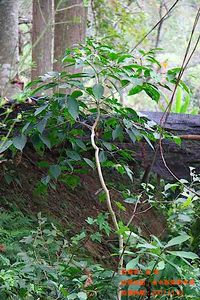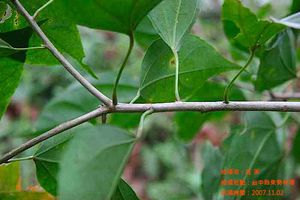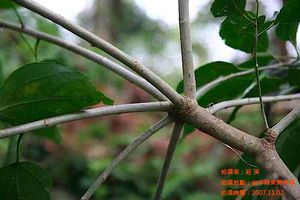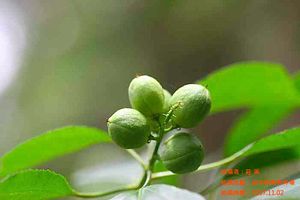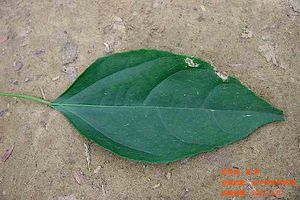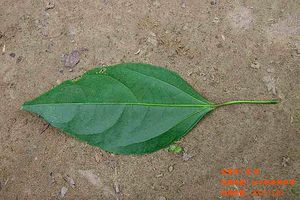巴豆
出自台灣有毒中草藥毒性資料庫
(→毒性研究) |
|||
| (10個中途的修訂版本沒有顯示) | |||
| 第1行: | 第1行: | ||
| - | [[http://tcm-toxic.kmu.edu.tw/index.php/%E5%A4%A7%E6%88%9F%E7%A7%91 | + | __NOTOC__ |
| + | {| | ||
| + | ||[http://tcm-toxic.kmu.edu.tw/index.php/%E5%AD%B8%E5%90%8D 中英文學名] | ||
| + | |||
| + | ||[http://tcm-toxic.kmu.edu.tw/index.php/%E5%A4%A7%E6%88%9F%E7%A7%91 科別] | ||
| + | |||
| + | ||[http://tcm-toxic.kmu.edu.tw/index.php/%E6%AF%92%E6%80%A7 毒性] | ||
| + | |||
| + | ||[http://tcm-toxic.kmu.edu.tw/index.php/%E7%97%87%E7%8B%80 症狀] | ||
| + | |} | ||
{{:模板:基本資料|1=大戟科 Euphorbiaceae|2=巴豆屬|3= 'Croton L.'|4=巴豆|5=''Croton tiglium'' L.|6=Purging croton |7= 巴菽、老陽子、紅仔人、貢仔、猛子仁、猛樹、管仔、落水金剛}} | {{:模板:基本資料|1=大戟科 Euphorbiaceae|2=巴豆屬|3= 'Croton L.'|4=巴豆|5=''Croton tiglium'' L.|6=Purging croton |7= 巴菽、老陽子、紅仔人、貢仔、猛子仁、猛樹、管仔、落水金剛}} | ||
| + | |||
== '''植物圖片''' == | == '''植物圖片''' == | ||
| + | <font size=4> | ||
{| border="2" style="border-collapse;" | {| border="2" style="border-collapse;" | ||
|| | || | ||
| - | [[檔案:巴豆.jpg | | + | [[檔案:巴豆.jpg |200px|巴豆]] |
巴豆全株 | 巴豆全株 | ||
| 第12行: | 第23行: | ||
巴豆葉序 | 巴豆葉序 | ||
| - | |||
| - | |||
|| | || | ||
[[檔案:巴豆-枝2.jpg|300px|巴豆枝]] | [[檔案:巴豆-枝2.jpg|300px|巴豆枝]] | ||
巴豆枝 | 巴豆枝 | ||
| + | || | ||
| + | |- | ||
|| | || | ||
[[檔案:巴豆-實2.jpg|300px|巴豆果實]] | [[檔案:巴豆-實2.jpg|300px|巴豆果實]] | ||
巴豆果實 | 巴豆果實 | ||
| - | |||
| - | |||
|| | || | ||
[[檔案:巴豆-葉正.jpg |300px|巴豆葉正面]] | [[檔案:巴豆-葉正.jpg |300px|巴豆葉正面]] | ||
| 第33行: | 第42行: | ||
巴豆葉背面 | 巴豆葉背面 | ||
|} | |} | ||
| + | </font> | ||
| + | |||
== '''巴豆簡介''' == | == '''巴豆簡介''' == | ||
| - | <font size= | + | <font size=4> 巴豆,大戟科巴豆屬巴豆樹的果實,本草綱目內記載為有毒中藥,使用方法大多均須除去巴豆外皮及種心才可作為外敷藥用,口服使用巴豆也須經過炮製後才可入藥。台灣毒藥物控制中心(Taiwan Poison Control Centers)的通報案例也記載有部分的人因為服用巴豆後產生典型的腸胃道刺激中毒症狀[1]。 |
巴豆的使用及研究歷史來由已經非常久遠,中醫最主要將巴豆作為峻瀉劑使用,後來經研究也發現巴豆內含的成分具有抗腫瘤,促進腫瘤生長,引起發炎等效果[2]。
目前確定的巴豆有毒成分為巴豆脂(phorbol ester),即為常稱的巴豆油,或佛波脂。巴豆脂目前已知可能會引起的毒性反應除了最明顯的腸胃道刺激外,另外也被證實為腫瘤促進劑(tumor-promoting agent)及發炎反應誘發物。</font>。 | 巴豆的使用及研究歷史來由已經非常久遠,中醫最主要將巴豆作為峻瀉劑使用,後來經研究也發現巴豆內含的成分具有抗腫瘤,促進腫瘤生長,引起發炎等效果[2]。
目前確定的巴豆有毒成分為巴豆脂(phorbol ester),即為常稱的巴豆油,或佛波脂。巴豆脂目前已知可能會引起的毒性反應除了最明顯的腸胃道刺激外,另外也被證實為腫瘤促進劑(tumor-promoting agent)及發炎反應誘發物。</font>。 | ||
| + | |||
== '''外觀簡述''' == | == '''外觀簡述''' == | ||
{| border="2" style="border-collapse;" | {| border="2" style="border-collapse;" | ||
|| | || | ||
| - | <font size= | + | <font size=4>'''莖'''</font> |
| - | ||<font size= | + | ||<font size=4>灌木或小樹,莖無毛光滑</font> |
|- | |- | ||
|| | || | ||
| - | <font size= | + | <font size=4>'''葉'''</font> |
| - | ||<font size= | + | ||<font size=4>葉具有膜質(membranaceous),呈卵圓形,長約5-14公分,寬約2-7公分。葉尖漸尖,葉基鈍角,葉柄約4公分長,細窄。</font> |
|- | |- | ||
|| | || | ||
| - | <font size= | + | <font size=4>'''花'''</font> |
| - | ||<font size= | + | ||<font size=4>雄花帶有星狀毛</font> |
|- | |- | ||
|| | || | ||
| - | <font size= | + | <font size=4>'''果實'''</font> |
| - | ||<font size= | + | ||<font size=4>果實橢圓形或橢球狀,3瓣狀,長約2公分,寬約1-1.5公分。種子橢圓卵形。</font> |
|} | |} | ||
| + | |||
== '''產地''' == | == '''產地''' == | ||
| - | <font size= | + | <font size=4> |
為印度馬來西亞和中國南部原生種,已在台灣栽培歸化,主要產在中南部及東部。</font> | 為印度馬來西亞和中國南部原生種,已在台灣栽培歸化,主要產在中南部及東部。</font> | ||
| - | |||
| - | *<font size= | + | == '''毒性研究''' == |
| - | <font size= | + | *<font size=4 color=green>'''症狀'''</font> |
| + | <font size=4>巴豆的使用基本上都是經過炮製,或是搗爛外敷,其所產生的巴豆油俱有強烈地瀉下作用,服用半滴至一滴巴豆油會使口腔或胃黏膜產生灼熱感且嘔吐,導致腸胃炎,約三小時內可能產生多次腹瀉,且劇烈腹痛。外敷巴豆油至皮膚上會引起強烈的刺激作用,可能產生紅腫熱痛,嚴重會導致膿疱產生,甚至皮膚壞死。</font> | ||
| - | *<font size= | + | *<font size=4 color=green>'''有毒成份'''</font> |
| - | <font size= | + | <font size=4>巴豆目前被確立的毒性成分為巴豆脂(phorbol ester),又稱巴豆油,另外其它許具有類似結構的phorbol ester衍生物也同樣具有毒性。巴豆脂目前已知會促進腫瘤的生長,產生發炎反應。 |
巴豆也含有一種毒蛋白,稱作巴豆毒蛋白(crotin),分有兩種結構,巴豆毒蛋白I(crotin I)及巴豆毒蛋白II(crotin II),分子量各為40 kDa及15 kDa,此兩種毒蛋白均是屬於單鏈毒蛋白,且均會抑制真核細胞中的蛋白質合成作用。I與II的抑制蛋白質合成作用和毒性相比之下,I的抑制合成較弱,但毒性較強[3, 4]。</font> | 巴豆也含有一種毒蛋白,稱作巴豆毒蛋白(crotin),分有兩種結構,巴豆毒蛋白I(crotin I)及巴豆毒蛋白II(crotin II),分子量各為40 kDa及15 kDa,此兩種毒蛋白均是屬於單鏈毒蛋白,且均會抑制真核細胞中的蛋白質合成作用。I與II的抑制蛋白質合成作用和毒性相比之下,I的抑制合成較弱,但毒性較強[3, 4]。</font> | ||
| - | *<font size= | + | *<font size=4 color=green>'''機轉'''</font> |
| - | <font size= | + | <font size=4>巴豆脂經由研究證實為腫瘤促進劑,而其促進腫瘤生長的機轉與細胞內訊息傳遞的影響有相關。巴豆脂進到體內後,會與細胞膜上的受體進行結合,與受體結合的動作為整個腫瘤生長影響的最初步驟。結合後,會影響人體內非常重要的蛋白激酶C(protein kinase C, PKC)訊息傳遞途徑來產生腫瘤促進的作用[5]。一般來說,正常體內的PKC都是屬於非活化的形態,PKC會先磷酸化後,與diacylglycerol (DAG)結合活化,才與RACK蛋白質(一種專門與活化型PKC結合的膜上受體)結合,進一步傳遞接下來的訊息。但,巴豆脂在作用上是一種DAG的類似物,因此取代了DAG原本的功能,會大量高度活化PKC,且巴豆脂-DAG結合非常不容易被水解,因此能持續活化PKC,刺激細胞增生。巴豆脂在活化PKC的動作上,是以一種不可逆的形式使PKC結合到細胞膜上[5-9]。</font> |
| + | |||
| + | *<font size=4 color=green>'''中毒劑量'''</font> | ||
| + | <font size=4>目前動物實驗指出巴豆粗萃取液及巴豆毒蛋白I和II的半數致死劑量(median lethal dose, LD50)分別為2.49, 0.45,及2.23 毫克/隻[3]。</font> | ||
| - | |||
| - | |||
=='''毒性分級'''== | =='''毒性分級'''== | ||
| - | <font size= | + | <font size=4>[http://tcm-toxic.kmu.edu.tw/index.php/%E6%AF%92%E6%80%A7%E5%88%86%E9%A1%9E 級數B, 等級3]</font> |
| + | |||
== '''參考文獻''' == | == '''參考文獻''' == | ||
| - | 1. Lin TJ, Nelson LS, Tsai JL et al. Common toxidromes of plant poisonings in Taiwan. Clinical toxicology (Philadelphia, Pa.) 2009; 47: 161-168. | + | <font size=4> |
| + | 1. Lin TJ, Nelson LS, Tsai JL et al. [http://www.ncbi.nlm.nih.gov/pubmed/18788001 Common toxidromes of plant poisonings in Taiwan.] ''Clinical toxicology (Philadelphia, Pa.)'' 2009; 47: 161-168. | ||
| - | 2. 徐春, 湯德元, 曾智勇 et al. 淺談大黃和巴豆的藥理作用研究. 世界農業 2007; 11: 52-55. | + | 2. 徐春, 湯德元, 曾智勇 et al. [http://d.wanfangdata.com.cn/periodical_shijny200711014.aspx 淺談大黃和巴豆的藥理作用研究.] ''世界農業'' 2007; 11: 52-55. |
| - | 3. 陳明晃, 潘克楨. 巴豆毒蛋白的分離、結晶及其性質研究. 中國生物化學與分子生物學報 1993; 9: 104-108. | + | 3. 陳明晃, 潘克楨. [http://cjbmb.bjmu.edu.cn/CN/abstract/abstract22139.shtml 巴豆毒蛋白的分離、結晶及其性質研究.] ''中國生物化學與分子生物學報'' 1993; 9: 104-108. |
| - | 4. Chen MH, Zhou KJ, Fu ZJ, Pan KZ. Preliminary crystallographic studies of crotin II. Journal of Molecular Biology 1993; 234: 908-909. | + | 4. Chen MH, Zhou KJ, Fu ZJ, Pan KZ. [http://www.ncbi.nlm.nih.gov/pubmed/8254687 Preliminary crystallographic studies of crotin II.] ''Journal of Molecular Biology'' 1993; 234: 908-909. |
| - | 5. Nishizuka Y. Intracellular signaling by hydrolysis of phospholipids and activation of protein kinase C. Science 1992; 258: 607-614. | + | 5. Nishizuka Y. [http://www.sciencemag.org/content/258/5082/607 Intracellular signaling by hydrolysis of phospholipids and activation of protein kinase C.] ''Science'' 1992; 258: 607-614. |
| - | 6. Mosior M, Newton AC. Mechanism of interaction of protein kinase C with phorbol esters. Reversibility and nature of membrane association. Journal of Biological Chemistry 1995; 270: 25526-25533. | + | 6. Mosior M, Newton AC. [http://www.ncbi.nlm.nih.gov/pubmed/7592722 Mechanism of interaction of protein kinase C with phorbol esters. Reversibility and nature of membrane association.] ''Journal of Biological Chemistry'' 1995; 270: 25526-25533. |
| - | 7. Segal A, Van Duuren BL, | + | 7. Segal A, Van Duuren BL, Maté U. [http://www.ncbi.nlm.nih.gov/pubmed/1149030 The Identification of Phorbolol Myristate Acetate as a New Metabolite of Phorbol Myristate Acetate in Mouse Skin.] ''Cancer Research'' 1975; 35: 2154-2159. |
| - | 8. Nishizuka Y. Protein kinase C and lipid signaling for sustained cellular responses. | + | 8. Nishizuka Y. [http://www.fasebj.org/content/9/7/484.abstract Protein kinase C and lipid signaling for sustained cellular responses.] ''The Journal of the Federation of American Societies for Experimental Biology'' 1995; 9: 484-496. |
| - | 9. Musashi M, Ota S, Shiroshita N. The role of protein kinase C isoforms in cell proliferation and apoptosis. International of Journal Hematology 2000; 72: 12-19. | + | 9. Musashi M, Ota S, Shiroshita N. [http://sciencelinks.jp/j-east/article/200103/000020010300A0808105.php The role of protein kinase C isoforms in cell proliferation and apoptosis.] ''International of Journal Hematology'' 2000; 72: 12-19. |
| + | </font> | ||
| + | {| | ||
| + | ||[http://tcm-toxic.kmu.edu.tw/index.php/%E5%AD%B8%E5%90%8D 中英文學名] | ||
| + | ||[http://tcm-toxic.kmu.edu.tw/index.php/%E5%A4%A7%E6%88%9F%E7%A7%91 科別] | ||
| - | [http://tcm-toxic.kmu.edu.tw/index.php/% | + | ||[http://tcm-toxic.kmu.edu.tw/index.php/%E6%AF%92%E6%80%A7 毒性] |
| + | |||
| + | ||[http://tcm-toxic.kmu.edu.tw/index.php/%E7%97%87%E7%8B%80 症狀] | ||
| + | |} | ||
在2012年7月3日 (二) 17:26的最新修訂版本
| 中英文學名 | 科別 | 毒性 | 症狀 |
基本資料
|
科別 | 大戟科 Euphorbiaceae |
|
屬名 | 巴豆屬 Croton L. |
|
中文學名 | 巴豆 |
|
拉丁學名 | Croton tiglium L. |
|
英文名稱 | Purging croton |
|
中文俗名 | 巴菽、老陽子、紅仔人、貢仔、猛子仁、猛樹、管仔、落水金剛 |
植物圖片
|
巴豆全株 |
巴豆葉序 |
巴豆枝 | |
|
巴豆果實 |
巴豆枝 |
巴豆葉背面 |
巴豆簡介
巴豆,大戟科巴豆屬巴豆樹的果實,本草綱目內記載為有毒中藥,使用方法大多均須除去巴豆外皮及種心才可作為外敷藥用,口服使用巴豆也須經過炮製後才可入藥。台灣毒藥物控制中心(Taiwan Poison Control Centers)的通報案例也記載有部分的人因為服用巴豆後產生典型的腸胃道刺激中毒症狀[1]。 巴豆的使用及研究歷史來由已經非常久遠,中醫最主要將巴豆作為峻瀉劑使用,後來經研究也發現巴豆內含的成分具有抗腫瘤,促進腫瘤生長,引起發炎等效果[2]。 目前確定的巴豆有毒成分為巴豆脂(phorbol ester),即為常稱的巴豆油,或佛波脂。巴豆脂目前已知可能會引起的毒性反應除了最明顯的腸胃道刺激外,另外也被證實為腫瘤促進劑(tumor-promoting agent)及發炎反應誘發物。。
外觀簡述
|
莖 | 灌木或小樹,莖無毛光滑 |
|
葉 | 葉具有膜質(membranaceous),呈卵圓形,長約5-14公分,寬約2-7公分。葉尖漸尖,葉基鈍角,葉柄約4公分長,細窄。 |
|
花 | 雄花帶有星狀毛 |
|
果實 | 果實橢圓形或橢球狀,3瓣狀,長約2公分,寬約1-1.5公分。種子橢圓卵形。 |
產地
為印度馬來西亞和中國南部原生種,已在台灣栽培歸化,主要產在中南部及東部。
毒性研究
- 症狀
巴豆的使用基本上都是經過炮製,或是搗爛外敷,其所產生的巴豆油俱有強烈地瀉下作用,服用半滴至一滴巴豆油會使口腔或胃黏膜產生灼熱感且嘔吐,導致腸胃炎,約三小時內可能產生多次腹瀉,且劇烈腹痛。外敷巴豆油至皮膚上會引起強烈的刺激作用,可能產生紅腫熱痛,嚴重會導致膿疱產生,甚至皮膚壞死。
- 有毒成份
巴豆目前被確立的毒性成分為巴豆脂(phorbol ester),又稱巴豆油,另外其它許具有類似結構的phorbol ester衍生物也同樣具有毒性。巴豆脂目前已知會促進腫瘤的生長,產生發炎反應。 巴豆也含有一種毒蛋白,稱作巴豆毒蛋白(crotin),分有兩種結構,巴豆毒蛋白I(crotin I)及巴豆毒蛋白II(crotin II),分子量各為40 kDa及15 kDa,此兩種毒蛋白均是屬於單鏈毒蛋白,且均會抑制真核細胞中的蛋白質合成作用。I與II的抑制蛋白質合成作用和毒性相比之下,I的抑制合成較弱,但毒性較強[3, 4]。
- 機轉
巴豆脂經由研究證實為腫瘤促進劑,而其促進腫瘤生長的機轉與細胞內訊息傳遞的影響有相關。巴豆脂進到體內後,會與細胞膜上的受體進行結合,與受體結合的動作為整個腫瘤生長影響的最初步驟。結合後,會影響人體內非常重要的蛋白激酶C(protein kinase C, PKC)訊息傳遞途徑來產生腫瘤促進的作用[5]。一般來說,正常體內的PKC都是屬於非活化的形態,PKC會先磷酸化後,與diacylglycerol (DAG)結合活化,才與RACK蛋白質(一種專門與活化型PKC結合的膜上受體)結合,進一步傳遞接下來的訊息。但,巴豆脂在作用上是一種DAG的類似物,因此取代了DAG原本的功能,會大量高度活化PKC,且巴豆脂-DAG結合非常不容易被水解,因此能持續活化PKC,刺激細胞增生。巴豆脂在活化PKC的動作上,是以一種不可逆的形式使PKC結合到細胞膜上[5-9]。
- 中毒劑量
目前動物實驗指出巴豆粗萃取液及巴豆毒蛋白I和II的半數致死劑量(median lethal dose, LD50)分別為2.49, 0.45,及2.23 毫克/隻[3]。
毒性分級
參考文獻
1. Lin TJ, Nelson LS, Tsai JL et al. Common toxidromes of plant poisonings in Taiwan. Clinical toxicology (Philadelphia, Pa.) 2009; 47: 161-168.
2. 徐春, 湯德元, 曾智勇 et al. 淺談大黃和巴豆的藥理作用研究. 世界農業 2007; 11: 52-55.
3. 陳明晃, 潘克楨. 巴豆毒蛋白的分離、結晶及其性質研究. 中國生物化學與分子生物學報 1993; 9: 104-108.
4. Chen MH, Zhou KJ, Fu ZJ, Pan KZ. Preliminary crystallographic studies of crotin II. Journal of Molecular Biology 1993; 234: 908-909.
5. Nishizuka Y. Intracellular signaling by hydrolysis of phospholipids and activation of protein kinase C. Science 1992; 258: 607-614.
6. Mosior M, Newton AC. Mechanism of interaction of protein kinase C with phorbol esters. Reversibility and nature of membrane association. Journal of Biological Chemistry 1995; 270: 25526-25533.
7. Segal A, Van Duuren BL, Maté U. The Identification of Phorbolol Myristate Acetate as a New Metabolite of Phorbol Myristate Acetate in Mouse Skin. Cancer Research 1975; 35: 2154-2159.
8. Nishizuka Y. Protein kinase C and lipid signaling for sustained cellular responses. The Journal of the Federation of American Societies for Experimental Biology 1995; 9: 484-496.
9. Musashi M, Ota S, Shiroshita N. The role of protein kinase C isoforms in cell proliferation and apoptosis. International of Journal Hematology 2000; 72: 12-19.
| 中英文學名 | 科別 | 毒性 | 症狀 |
